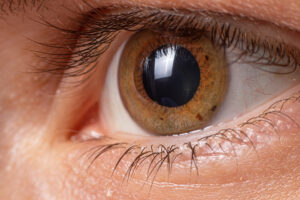December 1, 2023
By Dwight Akerman, OD, MBA, FAAO, FBCLA, FIACLE

Repeated low-level red-light therapy (RLRL) is a novel and promising intervention for myopia management. RLRL involves exposing the retina of a child or adolescent to a red light laser with a wavelength between 650 +/- 10 nanometers, twice daily for three minutes each time, with treatment separated by at least four hours in between and five to seven days per week. RLRL is available in several markets worldwide, but it is not FDA-approved or available in the United States.
Salzano et al. have written a comprehensive overview of the current evidence for utilizing RLRL to treat juvenile-onset myopia. The authors review the current evidence on the safety and efficacy of red light as a myopia control intervention, describe potential mechanisms, and discuss some key unresolved issues that require consideration before red light can be broadly translated into myopia control in children.
Several randomized controlled trials have now been published on the efficacy of red light in slowing myopia progression in children. One recent meta-analysis concluded that red-light therapy may be effective in slowing myopic progression. In these trials, this treatment is most commonly referred to as repeated low-level red-light therapy (RLRL) but has also been referred to as low-level light therapy (LLLT), low-level red-light (LLRL), or low-intensity red-light (LRL). All these currently published trials of low-level red-light therapy are in children of Chinese descent.
Choroidal thickness changes occurred in some studies, with thickening of the subfoveal choroid corresponding with many RLRL cohorts. One report found that thickening returned to baseline three months after treatment. As such, transient thickening and observed axial length shortening may indicate inflammation or phototoxic damage, but this is still unknown. Despite RLRL’s seemingly positive results, it should be noted that rebound effects were seen in two of the Chinese studies. The authors consider that atropine and orthokeratology also reported rebound effects, but not to the magnitude of these RLRL studies.
The exact mechanisms by which RLRL slows myopia progression are not fully understood, but there are several possible explanations. One possibility is that RLRL increases blood flow to the choroid, the layer of tissue that supplies blood to the retina. Increased choroidal blood flow may help reduce scleral hypoxia, a condition thought to play a role in myopia development. Another possibility is that RLRL stimulates the production of mitochondrial enzymes, which are responsible for energy production in cells. Increased mitochondrial enzyme production may help to improve the metabolism of the retina and choroid, which could also help to slow myopia progression.
Overall, the article by Salzano et al. is a well-written and informative review of RLRL in myopia management. The authors stress that precise characterization of treatment and parameters such as wavelengths, dose, and duration of therapy remain inconsistent and not replicable. Furthermore, the authors caution that the intervention, while promising, is not yet ready for clinical application. What is known about red light for myopia management is vastly outweighed by what is unknown.
Abstract
Repeated Low-Level Red-Light Therapy: The Next Wave in Myopia Management?
Aaron D Salzano , Safal Khanal, Nathan L Cheung, Katherine K Weise, Erin C Jenewein, Darryl M Horn, Donald O Mutti, Timothy J Gawne
Exposure to long-wavelength light has been proposed as a potential intervention to slow myopia progression in children. This article provides an evidence-based review of the safety and myopia control efficacy of red light and discusses the potential mechanisms by which red light may work to slow childhood myopia progression. The spectral composition of the ambient light in the visual environment has powerful effects on eye growth and refractive development. Studies in mammalian and primate animal models (macaque monkeys and tree shrews) have shown that daily exposure to long wavelength (red or amber) light promotes slower eye growth and hyperopia development and inhibits myopia induced by form deprivation or minus lens wear. Consistent with these results, several recent randomized controlled clinical trials in Chinese children have demonstrated that exposure to red light for three minutes twice a day significantly reduces myopia progression and axial elongation. These findings have collectively provided strong evidence for the potential of using red light as a myopia control intervention in clinical practice. However, several questions remain unanswered. In this article, we review the current evidence on the safety and efficacy of red light as a myopia control intervention, describe potential mechanisms, and discuss some key unresolved issues that require consideration before red light can be broadly translated into myopia control in children.
Salzano, A. D., Khanal, S., Cheung, N. L., Weise, K. K., Jenewein, E. C., Horn, D. M., … & Gawne, T. J. (2022). Repeated Low-level Red-light Therapy: The Next Wave in Myopia Management?. Optometry and Vision Science, 10-1097.
DOI: https://doi.org/10.1097/OPX.0000000000002083













